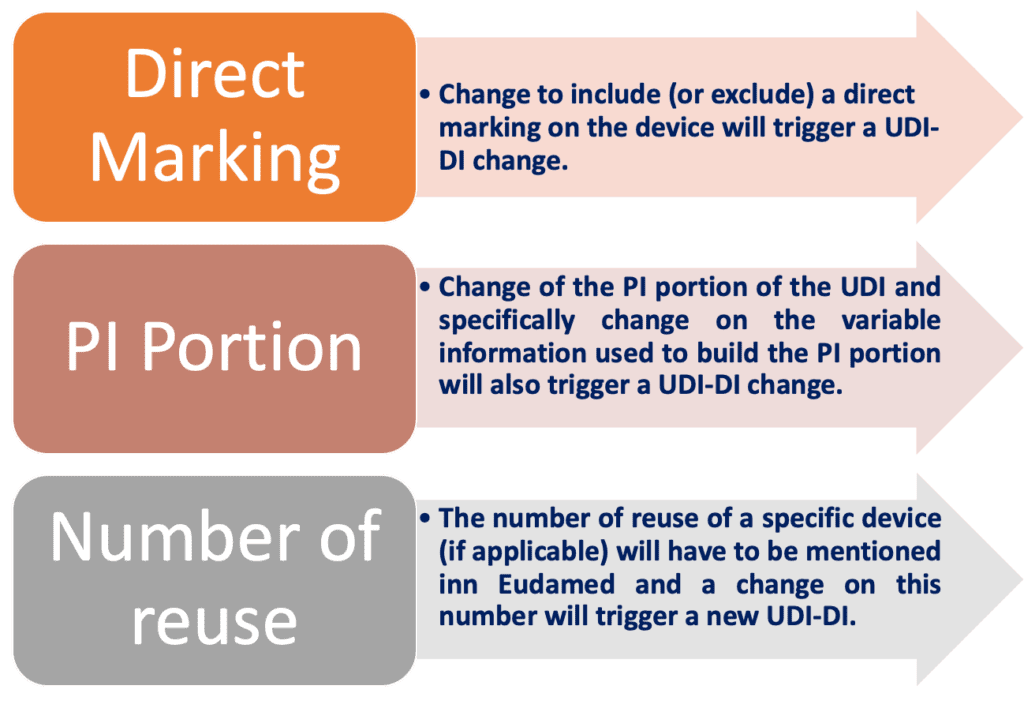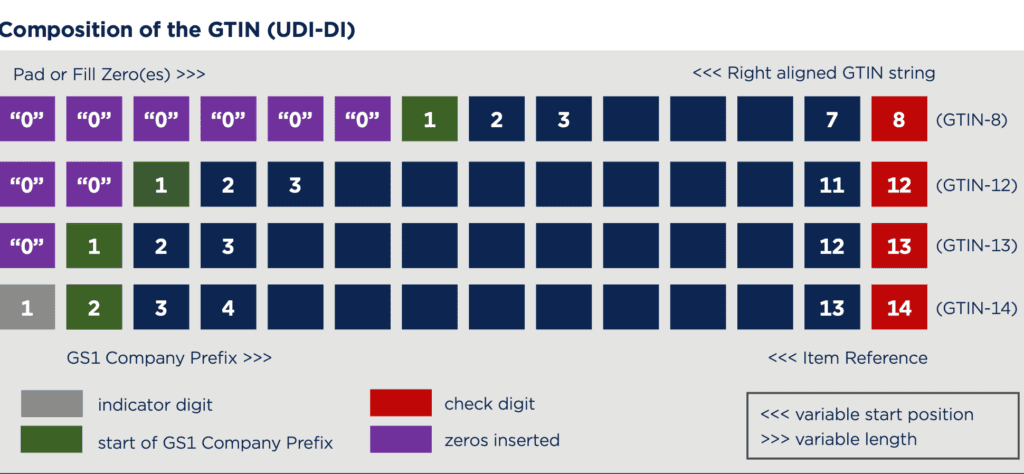The introduction of the UDI system for the medical device business can be considered a revolution and now the MDR and IVDR will soon be fully implemented, it is necessary to fully understand the UDI requirements for any type of devices that may br brought to the market.
We have already been talking of the UDI (Unique Device Identification) for the US market and the related FDA regulation and its importance over a broad range of quality and regulatory processes, from traceability to vigilance reporting and post-market surveillance.
In this article, we will go through the main requirements associated to the Unique Device Identification for medical device in the european market, according to the EU MDR and IVDR.
Overview of the Structure of UDI
As we have already been discussing, the Unique Device Identification is basically composed of two main elements:
- The Device Identifier (DI), that identifies the device.
- The Production Identifier (PI), that it identifies the specific batch of device and it is linked to specific variable information present in the label (such as, for example, manufacturing date, expiration date, serial number or lot number).
- Basic UDI-DI, this is a newly introduced with the EU MDR and IVDR. It is a part of the code that does not appear on the labels. It is used for administrative purpose and mentioned in EUDAMED and documentation such as Declaration of Conformity.
The basic UDI-DI can be considered the key factor to have access to a series of device-related information and therefore is referenced in relevant documentation (e.g., certificates, declaration of conformity, technical documentation). The basic UDI-DI has the objective of identifying (in a unique manner) and connect devices with the same intended purpose. For this reason, the basic UDI-DI can be linked to one or several UDI-DI.
EU Issuing Agencies
Similarly to the UDI system implemented by the FDA for the US market, also in the European Union the DI portion of the UDI is built through an issuing agency. The selected agency for EU are:
- Informationsstelle für Arzneispezialitäten (IFA GmbH)
- GS1 AISBL
- Health Industry Business Communications Council (HIBCC)
- ICCBBA
Three of these agencies are the same ones selected by the FDA for issuing UDI codes for the US market.
The Basic UDI-DI
The characteristic of the Basic UDI-DI have been described in a specific guideline issued by the Medical Device Coordination Group (MDCG 2018-1). As it is mentioned in the guideline, the Basic UDI-DI shall be included in the technical documentation to be assessed by the notified body, along with a series of other information aimed at identifying the devices, such as name, model and type, of the device or devices, the intended purpose as reported in the Information For Use.
The UDI-DI shall be associated to only one Basic UDI-DI.
Change of the UDI-DI shall be performed under specific situations:
- Change if the device is directly marked or not
- Change of the PI portion of the UDI code
- Change in the maximum number of reuse of the device.

Under these three situations, the Eudamed will force the creation of a new UDI-DI that, of course, will always be linked to the same Basic UDI-DI, that will not change.
How to Build a UDI code according to EU MDR and IVDR?
The structure of the UDI will depend from the issuing agency selected by the manufacturer; although the general characteristics of the UDI will remain the same, each agency has specific implementation rules that need to be followed.
For a matter of simplicity, we will provide a high level guideline on how to build the UDI according to GS1 implementation rules. We obviously encourage to look at the guideline of each issuing agency and select the one that is more convenient, based on the type of product you are placing on the market.
The structure of the UDI issued by GS1 according to MDR requirements
For GS1 agency, the UDI-DI code is based in the GTIN (Global Trade Item Number). The GTIN has been developed by GS1 and it used to look up product information in a database which may belong to a retailer, manufacturer, collector, researcher, or other entity. The type and length of GTIN used may depend from the barcode/datamatrix used. in fact, each AIDC system may need different type of GTIN.
The structure of the UDI-DI can change based on the number of digits we want to use, according to the following scheme, taken from a specific guideline developed by GS1:

So in few words, independently from the format of the GTIN code used, the UDI-DI can be built in the following way:
- Starting from the left, the company prefix number that is a number assigned to each company
- Then, moving on, there will be a sequential number the length of which will depend from the number of digit left. From example, if there are 5 digit left, the sequential number can be 00001, 00002 and so on.
- The last number is a check digiti that can automatically be calculated from a dedicated link provided by GS1: here .
The structure of the Basic UDI-DI according to MDR
Similarly to the UDI-DI, the GS1 provides guideline for the construction of the basic UDI-DI aligned with MDR requirements. This code is based on the so-called Global Model Number (GMN). The Global Model Number enables companies to uniquely identify the product model through the entire life cycle of the product: design – production – procurement – use – maintenance – disposal.
The Global Model Number has a maximum length of 25 characters, including two mandatory check characters. It is important to mention once again that the Basic UDI-DI (GMN) shall nt be encoded in a data carrier. The regulated medical device UDI-DI (GTIN) shall not be used as a replacement for Basic UDI-DI (GMN).
The general structure of the basic UDI-DI is reported in the scheme below:

Once again, it includes that company prefix number followed by an alphanumeric model reference that is related to the device or group of devices that will be linked to the specific Basic UDI-DI. The last two digits are the so-called check digits that can be automatically calculated (see this link).
Application of the UDI according to MDR and IVDR
One of the main impact of the UDI is linked to labelling requirements. UDI code and the related AIDC (Automatic Identification Data Capture, such as data matrix or bar code) needs to be mentioned in the label on the device and on the packaging. in fact, according to the IMDRF guideline, the UDI carrier must be available in both AIDC (automatic identification and data capture) and HRI (human readable interpretation) formats.
Moreover, great importance is the UDI in the context of data submission requirements and the related Eudamed database. The information to be submitted in the Eudamed database will not substantially differ from the ones to be included in the analogues GUDID database for the US market.
The UDI-DI will act as a key to the system, connecting all the information regarding a medical device available throughout the European electronic system. Patients and healthcare professionals would be able to identify UDI information from the label and access EUDAMED to obtain more information on the clinical and safety performance of the specific medical device.
Last, the UDI will definitely improve the traceability of the device, especially in the context of the European market where different stakeholders (distributors, authorised representative) play different roles in relation to the device. All stakeholders should be able to track who supplied and/or to whom they supplied a medical device.
Thus it is essential to have an adequate traceability system, that will also allow an appropriate identification of the device in case of adverse event reporting.
Compliance Checklist for Technical Documentation
In order to facilitate the control of the compliance of the technical documentation before submission of the dossier to the notified body, QualityMedDev has prepared a compliance checklist with a detailed list of all the requirements for technical documentation according to MDR 2017/745.
This Technical Documentation Checklist will be an essential tool to simplify the assessment of the conformity of your technical dossier. This 15-pages checklist is provided as a word file, thus fully editable to make it suitable according to the type of product your organization is bringing to the market.
Conclusions
In conclusion, we have been through the main requirements associated to the UDI system according to the European Medical Device Regulation and In-Vitro Diagnostic Regulation. We discussed the structure sure and the characteristics of the UDI, including the different portions of the code (Basic UDI-DI, UDI-DI, UDI-PI).
As examples, we provided a guideline to build the UDI according to the implementation guideline of one of the issuing agency that is supporting medical device manufacturers for UDI-related matter (GS1).
Subscribe to 4EasyReg Newsletter
4EasyReg is an online platform dedicated to Quality & Regulatory matters within the medical device industry. Have a look to all the services that we provide: we are very transparent in the pricing associated to these consulting services.
Within our WebShop, a wide range of procedures, templates, checklists are available, all of them focused on regulatory topics for medical device compliance to applicable regulations. Within the webshop, a dedicated section related to cybersecurity and compliance to ISO 27001 for medical device organizations is also present.
As one of the leading online platforms in the medical device sector, 4EasyReg offers extensive support for regulatory compliance. Our services cover a wide range of topics, from EU MDR & IVDR to ISO 13485, encompassing risk management, biocompatibility, usability, software verification and validation, and assistance in preparing technical documentation for MDR compliance.
Do not hesitate to subscribe to our Newsletter!
